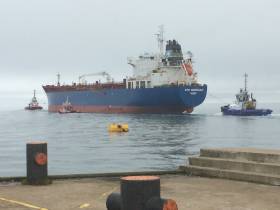Displaying items by tag: Towage Trio
Towage Trio Assist Biggest Ship to Port of Larne Depart Following Routine Maintenance
#Ports&Shipping - At 184m in length, CPO Germany which became the biggest ship ever to dock in the Port of Larne, departed the Co. Antrim port recently following routine maintenance, writes Jehan Ashmore
The London registered tanker at almost 20m longer than the port's regular ferry customers became the longest to berth. The ferries European Causeway and European Highlander which are near-sisters operate P&O Ferries route to Cairnryan on the North Channel.
Port of Larne is building a reputation in accommodating ships of all sizes and in managing an increasing amount of cargo, project cargo (i.e. wind turbines) and the aforementioned maintenance service to its portfolio in addition to other non-ferry related work.
Handing the operations of CPO Germany required the Port of Larne along with the Doyle Shipping Group (DSG). Among the duties required involved the deployment of tugs for the departure of the tanker. This saw a tug/workboat from the John McLoughlin & Son fleet located in the port joined by two tugs based in neighbouring Belfast Harbour.
As seen in the above photo at the tanker's bow is the red-hulled Merchantman. The 24.4m ASD bollard pull tug of 72 tons is based in Belfast Harbour and operated by SMS Towage that began business in the port during 2013. SMS Towage is an East Yorkshire company located in Hessle. The town is close to the Humber Bridge which is upriver of Kingstown-upon-Hull.
As previously reported on Afloat, ABP's Port of Hull invested in of a pair of Irish built ship-to-shore container cranes installed at the fourth busiest trading estuary in Europe. Afloat will have more to report on SMS operations at the UK North Sea port.






























































